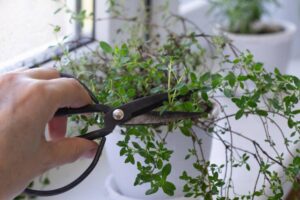The Interior Blog

Signs Your Plant May Be Harmful and Safer Alternatives
You’ve created a leafy oasis in your home. The sun pours in, your monstera is thriving, and there’s greenery in every room. But then comes the unsettling question: Is that plant actually safe for my dog? Or my curious toddler who likes to touch everything?
Unfortunately, many popular houseplants are toxic to pets and young children. While they might look lush and harmless, some can cause serious health issues when touched or ingested. The good news? You don’t need to ditch your dream of a green home — just make more informed choices.
In this guide, you’ll learn the key signs that a plant might be toxic, how to identify and deal with risky greenery, and most importantly, which safer, non-toxic alternatives can deliver the same style without the stress. Whether you’re just starting your plant journey or reassessing your collection, this is your essential plant safety guide.
Why indoor plant safety matters
The hidden risks in popular plants
Many trending houseplants — from snake plants to pothos — are on toxic plant lists. The issue isn’t necessarily a fatal risk, but rather the potential for irritation, illness, or allergic reaction in children and pets.
Symptoms of plant-related toxicity include:
- Drooling or vomiting in pets
- Oral irritation or swelling
- Rashes or skin irritation in children
- Digestive issues like diarrhoea
- Eye irritation if sap is transferred by touch
For example, the widely loved peace lily (Spathiphyllum) contains calcium oxalate crystals that can cause mouth pain and vomiting in cats and dogs — and even adults if accidentally ingested.
Common signs your plant might be harmful
So, how do you know if your plant poses a threat? While visual cues aren’t always reliable, there are some general warning signs that can raise suspicion.
1. Milky or sticky sap
If your plant bleeds a milky white substance when a leaf or stem is cut, this can be a red flag. Many sap-producing plants — like poinsettias or euphorbias — contain latex compounds that cause skin irritation or more serious reactions.
2. Bitter or metallic smell when cut
Some toxic plants emit strong, unnatural odours when damaged. While this isn’t definitive, it’s a cue to investigate further.
3. Sharp points or jagged edges
Plants like dieffenbachia (also known as dumb cane) have razor-like edges and toxic compounds in their stems. These often cause oral irritation or burning when chewed.
4. Curling or fuzzy leaves
While not always dangerous, some plants with decorative curling or furry textures, such as cyclamen, contain toxic alkaloids harmful to pets.
5. Sudden pet avoidance or drooling
If your dog or cat seems to avoid a plant or suddenly drools after contact, that may signal an issue. Keep a close eye on new behavioural changes after introducing any plant.
High-risk toxic indoor plants to avoid in family homes

Here are some commonly found toxic houseplants that are best avoided (or kept out of reach) in households with children or pets:
Plant NameToxic ToHarmful EffectsPeace LilyCats, Dogs, HumansMouth irritation, vomitingPothos (Devil’s Ivy)Cats, DogsOral pain, vomitingDieffenbachiaAllSevere oral irritation, swellingSnake PlantCats, DogsNausea, vomitingAloe VeraPetsDiarrhoea, vomiting (safe for humans)PhilodendronCats, DogsSwelling, difficulty swallowingZZ PlantAllToxic sap, eye and skin irritationSago PalmPetsHighly toxic — can cause liver failure
If you already own one of these and want to keep it, ensure it’s well out of reach and that any cuttings or fallen leaves are cleaned immediately.
What to do if you suspect plant poisoning
Act quickly if you notice:
- Your pet is chewing a plant and then vomiting or drooling
- A child rubbing their eyes after touching a plant
- Unexplained skin rashes following contact
Steps to follow:
- Remove access to the plant immediately.
- Take a photo of the plant for identification.
- Call your vet or NHS 111 (UK) for guidance.
- Bring a sample of the plant to medical professionals if needed.
Staying calm and informed can make all the difference in quick treatment.
Safe alternatives to toxic favourites
The best news? There are plenty of stylish, non-toxic plants that deliver the same design impact as their toxic counterparts — minus the risk.
Let’s compare common toxic favourites with safe swaps:
| Toxic Favourite | Safe Alternative | Why It Works |
| Peace Lily | Calathea | Similar upright form, patterned leaves |
| Pothos | Spider Plant | Cascading vines, air-purifying, pet-safe |
| Snake Plant | Areca Palm | Architectural leaves, pet-safe and tall |
| ZZ Plant | Parlour Palm | Tropical feel, safe for kids and pets |
| Dieffenbachia | Prayer Plant (Maranta) | Striking foliage, completely non-toxic |
| Philodendron | Peperomia | Compact and leafy, ideal for shelves |
| Aloe Vera | Haworthia | Succulent aesthetic, safer to keep indoors |
For a visual styling guide with safe choices, check out our post on the top 10 indoor plants safe for cats, dogs, and kids.
How to make your home safer today
Even if your plant collection includes a few high-risk species, there are practical steps you can take to improve overall indoor plant safety:
1. Elevate toxic plants
Place them on high, stable shelves or use ceiling-mounted hangers. Avoid any areas accessible to climbing pets or crawling children.
2. Label your plants

Use tags or stick-on labels underneath pots to remind you (and guests) which plants are safe and which aren’t.
3. Use plant apps for identification
Apps like PlantSnap or PictureThis can help you confirm a plant’s identity, which is especially useful if you’ve inherited greenery or purchased unnamed varieties.
4. Keep pet-friendly distractions nearby
Cats, in particular, are drawn to greenery. Provide pet grass or catnip in designated zones to satisfy their curiosity without risk.
Want to display greenery safely and stylishly? Our article on stylish placement ideas for non-toxic plants offers layout and styling inspiration for every room.
The psychological impact of safe greenery
It’s not just about health risks. Creating a safe, plant-filled environment reduces background stress. You won’t constantly worry about leaves falling, curious noses poking around, or daily inspections for chewed stems.
Safe greenery also encourages:
- More accessible plant care for kids (great for responsibility)
- A more relaxed home aesthetic
- Improved air quality and humidity — essential in dry climates or during winter heating
Conclusion: Create a home that grows safely
There’s no denying the joy that houseplants bring — from calming air purification to that soothing pop of green in every room. But when children and pets enter the mix, awareness becomes as important as aesthetics.
By recognising the signs of toxic indoor plants and choosing safer, stylish alternatives, you build a home that nurtures all who live in it. From the smallest spider plant to the tallest palm, you deserve peace of mind along with beautiful design.
Feeling inspired? Take a walk through your plant collection today. Cross-check your greenery, update labels, and consider a safe swap or two. Then let us know in the comments which plant you’re most proud to have made safer. Let’s grow together — responsibly.









